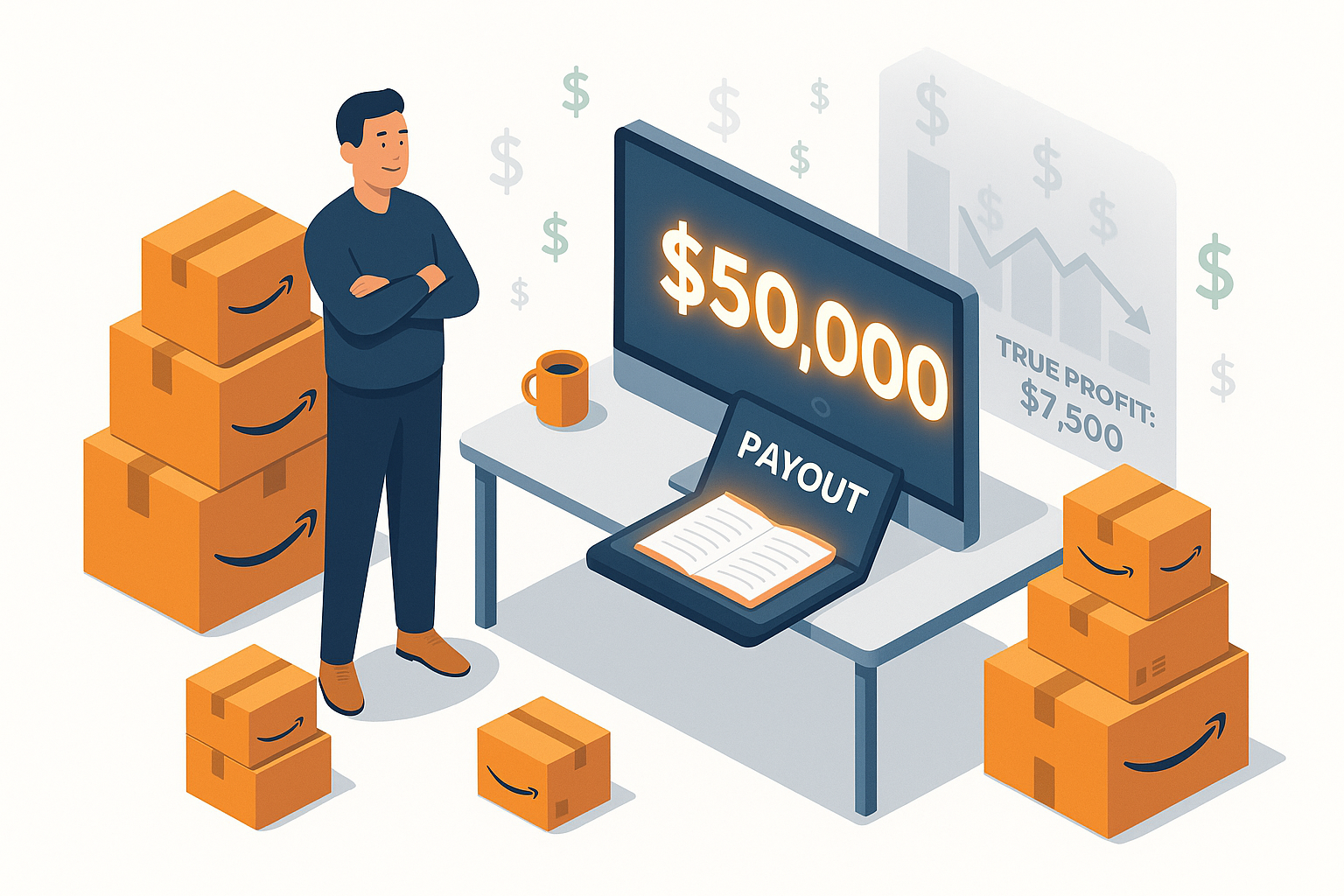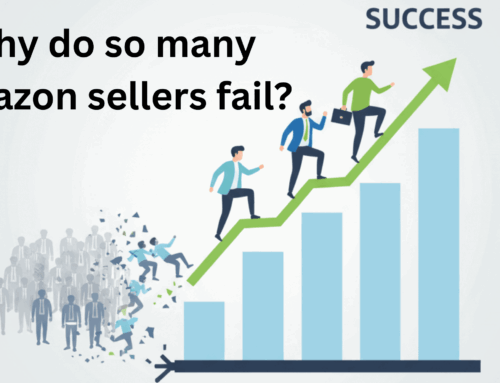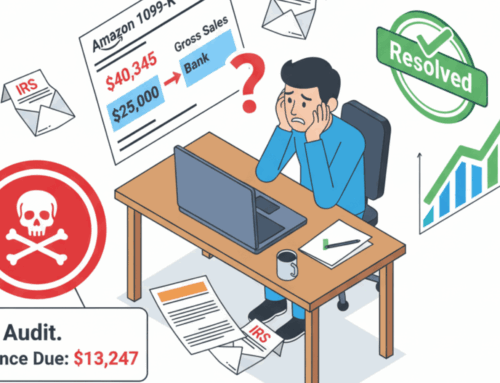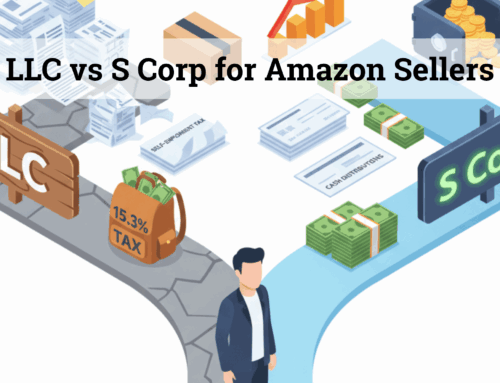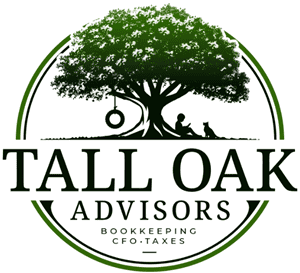Amazon Sellers Are Celebrating Fake Profits — Here’s the Math They’re Missing
key points
The Amazon FBA Bookkeeping 101
Amazon FBA bookkeeping isn’t just number-crunching — it’s the difference between feeling profitable and actually knowing your true margins.
Every Amazon seller knows the feeling of seeing that deposit hit their account. The number looks big. It feels like success. But here’s the uncomfortable truth: the Amazon payout is not your profit. It’s just a net figure after Amazon has already pulled fees, ads, and returns — and without proper bookkeeping, you have no way of knowing if you’re really making money.
That’s why so many sellers, even those hitting six or seven figures in sales, end up blindsided.

Table of Contents
- The Amazon FBA Bookkeeping 101
- Marc’s Story: The Spreadsheet Trap
- Ariel’s story: $1M in sales, 0 in clarity
- Why Amazon FBA Bookkeeping Is Different
- So, How Much Does It Cost?
- What Bookkeeping Isn’t
- The Cost Of Bad Data vs. Clean Books for Amazon Seller
- Why Waiting Makes It Worse
- FAQs
- Profit Clarity Is The Real ROI for Amazon Seller
Marc’s Story: The Spreadsheet Trap
Marc started small and tracked everything in spreadsheets. As his sales grew, so did the chaos. Eventually, he tried QuickBooks on his own, but things didn’t add up.
One month showed “no profit.” The next showed a negative number that didn’t make sense. If he updated one mapping, the whole report shifted. He told us, “I don’t even know if I’m overpaying or underpaying taxes. I don’t know if these profits are real.”
Marc’s problem wasn’t sales — it was running blind on bad data.
Have you ever looked at your numbers and thought, “These can’t be right”?
Book a free clarity call and we’ll show you what’s really going on.


Ariel’s story: $1M in sales, 0 in clarity
Ariel’s business grew fast, passing $1 million in annual sales. On paper, it looked like a dream. But behind the scenes, the books were always three months behind. Her husband, an accountant, was handling them — but even he couldn’t keep up with Amazon’s complexity.
When Ariel asked, “How much cash can I safely pull?” she couldn’t get an answer. When she wanted to know which products to double down on, the numbers weren’t ready. The success on the outside didn’t match the uncertainty on the inside.
Both Marc and Ariel highlight the same truth: without clean, up-to-date books, sales volume doesn’t matter. You can sell a lot and still not know if you’re making money.
Why Amazon FBA Bookkeeping Is Different
Bookkeeping for Amazon FBA isn’t like bookkeeping for a brick-and-mortar store. Here’s why:
- Fees are buried. FBA fees, referral fees, storage costs, and more all reduce margins — but don’t show up in the payout.
- Advertising is delayed. Spend often shows up after the revenue is booked, throwing off timing.
- Refunds change the picture. Returns can appear weeks later, cutting into profit long after the sale.
- Reimbursements exist — but you have to track them. If you don’t, that’s money lost.
This complexity is why operational tools like Sellerboard or InventoryLab exist. They’re great for tracking buy costs, inventory value, and SKU-level performance. But they’re not bookkeeping systems — and they don’t line up with QuickBooks. We don’t try to make them match.
For true financials — the kind you use for taxes, compliance, and cash planning — QuickBooks Online is the single source of truth.

So, How Much Does It Cost?
For most Amazon sellers, professional bookkeeping runs $300 to $2,000 per month, depending on the complexity of your setup.
Here’s what really drives that cost:

1. Number of bank accounts and credit cards
One bank account and two cards? Easy. Twelve cards and three banks? That’s dozens of extra reconciliations each month.
2. Your software stack
We recommend using Sellerboard or InventoryLab for operations only, and QBO for financials. The more tools you connect, the more potential mismatches and manual work there is to clean up.
3. Number of marketplaces and currencies
Sticking to Amazon US is simple. Add Canada, UK, or EU, and you’re now managing multiple deposits, exchange rates, and compliance touchpoints. We record the deposits into QBO, but the extra flows increase the complexity.
4. Amazon seller business model
- Private Label: large purchase orders, heavy ad spend.
- Wholesale: vendor invoices and larger supplier payments.
- OA/RA: dozens or hundreds of small card transactions.
- Dropship: messy refunds and disputes.
Each model affects how transactions flow through your books, which changes the workload.
5. Transaction volume
A handful of big POs is easier to reconcile than hundreds of small receipts. Volume directly drives time and cost.

What Bookkeeping Isn’t
It’s just as important to be clear about what bookkeeping does not include:
- Reconciling Sellerboard or InventoryLab to QuickBooks.
- SKU-level COGS, bundles, or cycle counts.
- Mapping ads directly to orders.
- Running reimbursement sweeps.
Those are operational processes, not bookkeeping. Our role is making sure your QBO financials are clean, reconciled, and tax-ready.


The Cost Of Bad Data vs. Clean Books for Amazon Seller
Let’s put this in perspective.
- Bookkeeping: $600–$1,200/month for most growing sellers.
- Cleanup after a year of messy books: $5K–$10K.
- One tax mistake: $20K–$30K.
- Ordering inventory based on fake profits: $50K+ locked up.
When you anchor the bookkeeping fee against those risks, it’s obvious which is cheaper.
Why Waiting Makes It Worse
Every month you delay clean books adds more mess to untangle later. Every inventory order made without clarity carries more risk. Every tax season without reconciled numbers increases the chance of a painful bill.
The cost of waiting is always higher than the cost of starting now.
FAQs
Do I need bookkeeping if I only sell on Amazon US?
Yes. Even a single marketplace has fees, ads, returns, and reimbursements that don’t show up in the payout.
Can you make Sellerboard match QuickBooks?
No. They serve different purposes. Sellerboard is for SKU-level insights. QuickBooks is for financials.
Do you do SKU-level profitability?
No. That’s an operational task for tools like Sellerboard or InventoryLab.
Do you handle reimbursements or ads mapping?
No. Our focus is clean financial statements in QBO.
What if I sell internationally?
We capture the deposits into QBO, but local tax filings (like VAT/GST) require separate support.

Profit Clarity Is The Real ROI for Amazon Seller
Marc and Ariel both looked successful on the surface — but both were flying blind underneath. That’s the risk of relying on payouts, spreadsheets, or delayed books.
Amazon bookkeeping costs $300–$2,000/month depending on complexity, but the real ROI is clarity: knowing your true profit, staying compliant, and making confident decisions.
Don’t wait until you find out the hard way that your profit was just an illusion.
Take Control of Your Finances Today!
Whether you’re a Reseller (Wholesale, Retail Arbitrage, Online Arbitrage, Dropshipping) or a Brand Owner, managing finances is key to your success. We support eCommerce businesses across major platforms like Amazon, Shopify, eBay, Walmart, Etsy, BigCommerce, and beyond.
See if you qualify for a free strategy session with our team to learn how Tall Oak Advisors can streamline your bookkeeping and ensure accurate tax preparation for your business.
Need a quick quote?
Or explore our range of free resources crafted specifically for eCommerce sellers:
- Business Tax Worksheet
- Frequently Asked Questions About Taxes and Bookkeeping
- Tax Write-Offs Every Amazon and Shopify Seller Should Know
Take the first step toward a stronger financial future and position your business for long-term success.
Amazon Sellers Are Celebrating Fake Profits — Here’s the Math They’re Missing
key points
The Amazon FBA Bookkeeping 101
Amazon FBA bookkeeping isn’t just number-crunching — it’s the difference between feeling profitable and actually knowing your true margins.
Every Amazon seller knows the feeling of seeing that deposit hit their account. The number looks big. It feels like success. But here’s the uncomfortable truth: the Amazon payout is not your profit. It’s just a net figure after Amazon has already pulled fees, ads, and returns — and without proper bookkeeping, you have no way of knowing if you’re really making money.
That’s why so many sellers, even those hitting six or seven figures in sales, end up blindsided.

Table of Contents
- The Amazon FBA Bookkeeping 101
- Marc’s Story: The Spreadsheet Trap
- Ariel’s story: $1M in sales, 0 in clarity
- Why Amazon FBA Bookkeeping Is Different
- So, How Much Does It Cost?
- What Bookkeeping Isn’t
- The Cost Of Bad Data vs. Clean Books for Amazon Seller
- Why Waiting Makes It Worse
- FAQs
- Profit Clarity Is The Real ROI for Amazon Seller
Marc’s Story: The Spreadsheet Trap
Marc started small and tracked everything in spreadsheets. As his sales grew, so did the chaos. Eventually, he tried QuickBooks on his own, but things didn’t add up.
One month showed “no profit.” The next showed a negative number that didn’t make sense. If he updated one mapping, the whole report shifted. He told us, “I don’t even know if I’m overpaying or underpaying taxes. I don’t know if these profits are real.”
Marc’s problem wasn’t sales — it was running blind on bad data.
Have you ever looked at your numbers and thought, “These can’t be right”?
Book a free clarity call and we’ll show you what’s really going on.


Ariel’s story: $1M in sales, 0 in clarity
Ariel’s business grew fast, passing $1 million in annual sales. On paper, it looked like a dream. But behind the scenes, the books were always three months behind. Her husband, an accountant, was handling them — but even he couldn’t keep up with Amazon’s complexity.
When Ariel asked, “How much cash can I safely pull?” she couldn’t get an answer. When she wanted to know which products to double down on, the numbers weren’t ready. The success on the outside didn’t match the uncertainty on the inside.
Both Marc and Ariel highlight the same truth: without clean, up-to-date books, sales volume doesn’t matter. You can sell a lot and still not know if you’re making money.
Why Amazon FBA Bookkeeping Is Different
Bookkeeping for Amazon FBA isn’t like bookkeeping for a brick-and-mortar store. Here’s why:
- Fees are buried. FBA fees, referral fees, storage costs, and more all reduce margins — but don’t show up in the payout.
- Advertising is delayed. Spend often shows up after the revenue is booked, throwing off timing.
- Refunds change the picture. Returns can appear weeks later, cutting into profit long after the sale.
- Reimbursements exist — but you have to track them. If you don’t, that’s money lost.
This complexity is why operational tools like Sellerboard or InventoryLab exist. They’re great for tracking buy costs, inventory value, and SKU-level performance. But they’re not bookkeeping systems — and they don’t line up with QuickBooks. We don’t try to make them match.
For true financials — the kind you use for taxes, compliance, and cash planning — QuickBooks Online is the single source of truth.

So, How Much Does It Cost?
For most Amazon sellers, professional bookkeeping runs $300 to $2,000 per month, depending on the complexity of your setup.
Here’s what really drives that cost:

1. Number of bank accounts and credit cards
One bank account and two cards? Easy. Twelve cards and three banks? That’s dozens of extra reconciliations each month.
2. Your software stack
We recommend using Sellerboard or InventoryLab for operations only, and QBO for financials. The more tools you connect, the more potential mismatches and manual work there is to clean up.
3. Number of marketplaces and currencies
Sticking to Amazon US is simple. Add Canada, UK, or EU, and you’re now managing multiple deposits, exchange rates, and compliance touchpoints. We record the deposits into QBO, but the extra flows increase the complexity.
4. Amazon seller business model
- Private Label: large purchase orders, heavy ad spend.
- Wholesale: vendor invoices and larger supplier payments.
- OA/RA: dozens or hundreds of small card transactions.
- Dropship: messy refunds and disputes.
Each model affects how transactions flow through your books, which changes the workload.
5. Transaction volume
A handful of big POs is easier to reconcile than hundreds of small receipts. Volume directly drives time and cost.

What Bookkeeping Isn’t
It’s just as important to be clear about what bookkeeping does not include:
- Reconciling Sellerboard or InventoryLab to QuickBooks.
- SKU-level COGS, bundles, or cycle counts.
- Mapping ads directly to orders.
- Running reimbursement sweeps.
Those are operational processes, not bookkeeping. Our role is making sure your QBO financials are clean, reconciled, and tax-ready.


The Cost Of Bad Data vs. Clean Books for Amazon Seller
Let’s put this in perspective.
- Bookkeeping: $600–$1,200/month for most growing sellers.
- Cleanup after a year of messy books: $5K–$10K.
- One tax mistake: $20K–$30K.
- Ordering inventory based on fake profits: $50K+ locked up.
When you anchor the bookkeeping fee against those risks, it’s obvious which is cheaper.
Why Waiting Makes It Worse
Every month you delay clean books adds more mess to untangle later. Every inventory order made without clarity carries more risk. Every tax season without reconciled numbers increases the chance of a painful bill.
The cost of waiting is always higher than the cost of starting now.
FAQs
Do I need bookkeeping if I only sell on Amazon US?
Yes. Even a single marketplace has fees, ads, returns, and reimbursements that don’t show up in the payout.
Can you make Sellerboard match QuickBooks?
No. They serve different purposes. Sellerboard is for SKU-level insights. QuickBooks is for financials.
Do you do SKU-level profitability?
No. That’s an operational task for tools like Sellerboard or InventoryLab.
Do you handle reimbursements or ads mapping?
No. Our focus is clean financial statements in QBO.
What if I sell internationally?
We capture the deposits into QBO, but local tax filings (like VAT/GST) require separate support.

Profit Clarity Is The Real ROI for Amazon Seller
Marc and Ariel both looked successful on the surface — but both were flying blind underneath. That’s the risk of relying on payouts, spreadsheets, or delayed books.
Amazon bookkeeping costs $300–$2,000/month depending on complexity, but the real ROI is clarity: knowing your true profit, staying compliant, and making confident decisions.
Don’t wait until you find out the hard way that your profit was just an illusion.
Take Control of Your Finances Today!
Whether you’re a Reseller (Wholesale, Retail Arbitrage, Online Arbitrage, Dropshipping) or a Brand Owner, managing finances is key to your success. We support eCommerce businesses across major platforms like Amazon, Shopify, eBay, Walmart, Etsy, BigCommerce, and beyond.
See if you qualify for a free strategy session with our team to learn how Tall Oak Advisors can streamline your bookkeeping and ensure accurate tax preparation for your business.
Need a quick quote?
Or explore our range of free resources crafted specifically for eCommerce sellers:
- 7 Profit Crushing Mistakes That Will Destroy Your eCommerce Business
- Business Tax Worksheet
- Frequently Asked Questions About Taxes and Bookkeeping
- Tax Write-Offs Every Amazon and Shopify Seller Should Know
Take the first step toward a stronger financial future and position your business for long-term success.

